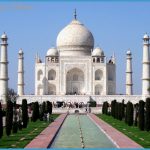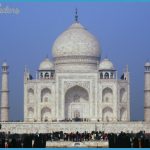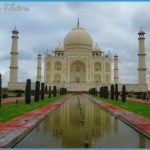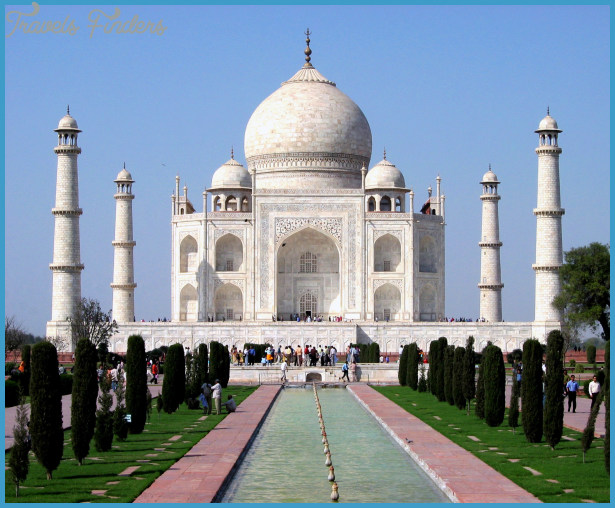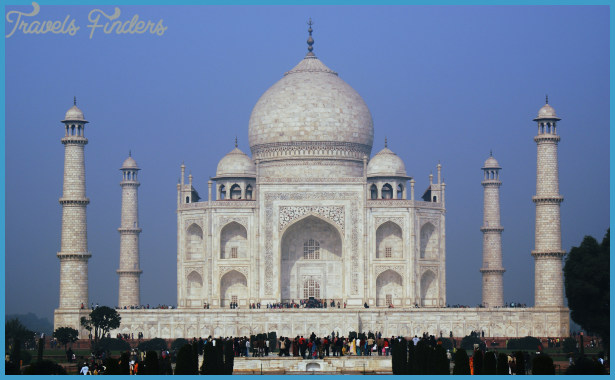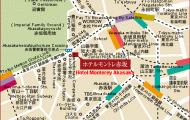MUGHAL MAUSOLEUM AGRA, INDIA
ARCHITECT UNKNOWN
A vision of shimmering white marble, the Taj Mahal was built by the Mughal emperor, Shah Jahan, as a mausoleum for his favorite wife, Mumtaz Mahal, who died shortly after giving birth to her fourteenth child in 1631. Work began the following year, and the structure was finally completed in 1648, while the landscaping of the gardens and the construction of the surrounding buildings continued for several more years. At the end of his life, Shah Jahan was also entombed in the Taj Mahal alongside his wife.
From the mid-16th century onward, the Mughal rulers began to create a distinctive style of architecture and built a number of notable tombs for members of the royal family. The simplest of these were cube-shaped stone or brick structures, surmounted with a dome. Other, more elaborate tombs included the mausoleum of the emperor Humayun in Delhi. Built according to a complex plan and featuring a central octagonal hall, Humayun’s tomb shares many features with the Taj Mahal and had a strong influence on its design. The identity of the architect of Mumtaz Mahal’s mausoleum has not been established, but it may have been Ustad Ahmad, who designed other buildings for Shah Jahan, including Delhi’s grand Red Fort.
Although influenced by earlier buildings, the proportions of the Taj Mahal-the symmetry of the large and small arches, the relationship between the central onion-shaped dome and the smaller domes of the minarets, and the way the building is set on its raised terrace-combine to place the building in a category of its own. Its graceful quality is further enhanced by the canal of still water in front of it, which creates a mirror image of the building, and by the carvings on the white marble fagades, inlaid with colored stone. Supremely intricate and of great beauty, they add exquisite pattern and texture.
SHAH JAHAN c. 1592-1666 CE
The fifth emperor of the Mughal dynasty and grandson of the great emperor Akbar, Shah Jahan became the ruler of India in 1627. An able, vigorous ruler, he improved and centralized the Mughal administration while at the same time spending many years on military campaigns in order to expand and consolidate his empire. Shah Jahan was a notable patron of the arts, from painting to poetry, but he is remembered above all for his architectural achievements. An enthusiastic commissioner of buildings, he constructed the magnificent Red Fort and the Jama Masjid mosque in Delhi, parts of the fort at Lahore, and a mausoleum for his father, Jahangir. While still a teenager, Shah Jahan married Arjumand Banu Begam, who became known as Mumtaz Mahal (jewel of the palace) and, despite taking other wives, he was devastated by her death and remained devoted to her. Shah Jahan’s reign ended when he became ill in 1658. After a dispute, the throne passed to his son Aurangzeb.
Visual tour: exterior
2 THE DOME Raised on a drum of masonry to give it extra height, the central dome rises to some 200ft (61m). The white marble masonry bulges to give the dome its onion-shaped exterior, but the inner ceiling has straight sides.
The dome has thick walls, to give extra height from outside while avoiding excessive height within
The minarets are said to lean outward slightly to create the illusion that they are straight when seen from the garden
1 FINIAL The main dome’s gilded finial incorporates both Islamic motifs, such as the crescent moon, and Hindu elements, including the bulbous water vessel.
A long water channel reflects the building
1 MINARETS On a mosque the minarets are towers from which the call to prayer is given. The minarets of the Taj Mahal are just ornamental and frame the main building.
4 CHHATRIS
Small pavilions that have a domed roof standing on slender pillars are called chhatris (umbrellas). Those on the roof of the Taj Mahal have ornate, multifoil (multi-lobed) arches between the pillars, which match those on the minarets.
2 PINNACLES
Slender, octagonal marble pinnacles with chevron-patterned, inlaid shafts topped with lotus-petal motifs stand at each corner of the building. They add sculptural interest to the Taj Mahal’s silhouette against the sky.
1 QURANIC INSCRIPTIONS AND INLAID DECORATION
The flowing script of the Qur’anic verses, seen on the upper section of this detail, was carved by calligrapher Amanat Khan, who signed his work. He is, however, the only one among the many artists and craftworkers employed on the mausoleum whose identity is known for certain. Below the verses and immediately above the arch, the colorful inlaid decoration features stylized leaves, stems, and flowers.
1 RELIEF CARVING
Symmetrically arranged plants and flowers carved in shallow relief are also found on the exterior. The strong sunlight catches the raised stems and blooms, giving form and texture to the fagade.
IN CONTEXT
The Mughal dynasty ruled India from the early 16th to the early 18th century. During this time a style of architecture evolved that drew on the buildings of their ancestors in central Asia as well as on those of their Muslim predecessors in India, the Delhi sultans of the 13th and 14th centuries. Including elements such as onion domes, straight-sided pointed arches, and multifoil arches that were seen in both Persian and Delhi architecture, the Mughals favored more restrained color schemes than many central Asian buildings, which often boasted brightly colored tiles. Although the Mughals were skilled military architects the emperor Akbar built a notable city at Fatehpur Sikri near Agra their most outstanding buildings were tombs. The Mughal tombs were more elaborate than those of the earlier Delhi sultans, incorporating complex plans and intricate decoration, and the Taj Mahal is the most elaborate of all.
Humayun’s Tomb, which was built in the 1560s, was a predecessor of the Taj Mahal. It has a large dome, chhatris, an octagonal central hall, and a raised terrace-all features later incorporated in the Taj Mahal.
ON SITE
Shah Jahan selected the site of the Taj Mahal with great care, choosing a position by the River Yamuna so that the building would be reflected in its water, and elevating the mausoleum on a raised terrace between the river and its garden. Following a geometric plan, the garden is divided into four sections, each separated by channels of water that meet at a central pool. The fourfold gardens of Islam represent the unity that underlies the teachings of the Qur’an, and the watercourses symbolize the four rivers of life, flowing with water, milk, honey, and wine.
Mosque Sandstone wall Gateway
1 Plan of the tomb and garden
The visitor goes through a gateway and past other tombs before entering the garden in front of the Taj Mahal. The Taj is flanked by a mosque and a matching building called the Mehman Khana.
3 ARCHED PORTAL The centerpiece of each fagade is a large arched opening containing a doorway, a window, and an array of carved and inlaid decoration. Around this opening is an inscription from the 36th Sura of the Qur’an, which speaks of God’s gifts to humanity on Earth and the promise of eternal life to the faithful.
Visual tour: interior
4 CENOTAPH Muslim custom favors simple tombs, and both Mumtaz Mahal and Shah Jahan were laid to rest in plain sarcophagi on the Taj Mahal’s lower floor. On the main level are elaborately decorated cenotaphs (empty tombs) commemorating the emperor and his wife. The cenotaph of Mumtaz, who died before her husband, was placed in the center of the building.
1 JALI An eight-sided lattice-work screen called a jalisurrounds the two cenotaphs. The original jali was made of gold but Shah Jahan replaced it with this marble one, in an intricate tracery pattern, because he feared that the gold screen might be stolen.
1 GEOMETRIC FLOOR PATTERN
The marble floors are tiled in a typical Islamic pattern made up of stars and crosslike shapes. Islamic artists used their understanding of geometry to develop many similarly ornate interlocking patterns.
1 EPITAPH At the foot end of the empty tomb of Mumtaz Mahal is an inscription identifying the queen. The sides are inscribed with quotations from the Qur’an, which were intended to comfort the soul of the deceased.
APEX OF THE DOME Even at the very highest point in the interior, at the limits of human eyesight, the meticulous patterning continues. On closer inspection the network of interlocking triangles and a sunlike design at the center is apparent.
SCREEN SUPPORTS At each corner of the jali are supporting posts that are faced with inlaid white marble. Their decoration reflects the patterns around the bases of the cenotaphs and in the spandrels (triangular areas between the arches and above the windows).
ON DESIGN
Many of the wall surfaces are decorated with inlaid patterns using a range of semi-precious stones including cornelian, coral, jade, jasper, lapis lazuli, onyx, and turquoise. The style probably shows the influence of the Italian technique called pietra dura (meaning hard stone), and western scholars once thought that European craft workers came to Agra to work on the building. This is very unlikely. There were examples of Italian inlaid furniture at the Mughal court, and there may also have been books in the libraries that included these designs. The artisans working at the Taj Mahal adapted these, but used their own color schemes and patterns.
Islam prohibited representational art, and the ban was especially strict when it came to portraying ”higher forms of life, such as people or animals. Designs based on plant forms were far more acceptable, and the decorators of the Taj Mahal used them extensively in their inlays, to stunning effect.
1 Elaborate inlays
Flowers, leaves, and vines in a variety of greens, reds, and yellows enliven the white marble inside the Taj Mahal.
ON DETAIL
The mix of plant designs and abstract motifs found in the Taj Mahal’s pietra dura decoration is also used in another form of adornment carvings in low relief found widely in the interior of the building. In this work, however, the designs are in stone of a single color, usually the white marble that is used as a facing material. This stone came from quarries at Makrana in Rajasthan, and a number of letters from the emperor survive, ordering supplies of the stone. These letters also demand that masons come from Rajasthan to Agra to carve the material, disproving older theories about European involvement in the work. The Rajasthani carvers were highly skilled, producing beautiful and accurate representations of the forms of flowers and leaves.
1 Exquisite carvings
Details from the reliefs show the carvers’ skill at producing both geometric designs and decorations based on plant motifs.

